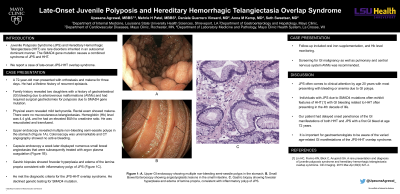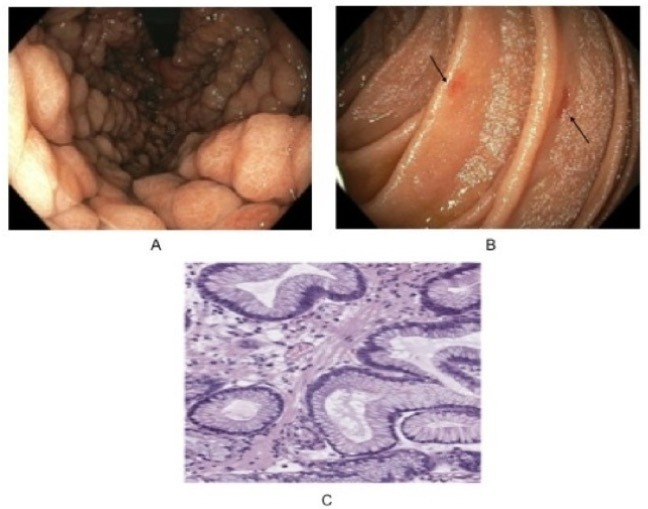Back


Poster Session E - Tuesday Afternoon
Category: General Endoscopy
E0292 - Late-Onset Juvenile Polyposis and Hereditary Hemorrhagic Telangiectasia Overlap Syndrome
Tuesday, October 25, 2022
3:00 PM – 5:00 PM ET
Location: Crown Ballroom

Has Audio

Upasana Agrawal, MBBS
LSU Health Sciences Center
Shreveport, LA
Presenting Author(s)
Upasana Agrawal, MBBS1, Mehrie Harshad Patel, MBBS2, Daniela Guerrero Vinsard, MD2, Anna M. Kemp, MD3, Seth Sweetser, MD2
1LSU Health Sciences Center, Shreveport, LA; 2Mayo Clinic, Rochester, MN; 3Mayo Clinic Health System, La Crosse, WI
Introduction: Juvenile Polyposis Syndrome (JPS) and Hereditary Hemorrhagic Telangiectasia (HHT) are rare disorders inherited in an autosomal dominant manner. The SMAD4 gene mutation causes a combined syndrome of JPS and HHT. We report a case of late-onset JPS-HHT overlap syndrome.
Case Description/Methods: A 72-year-old man presented with orthostasis and melena for three days. He had a lifetime history of recurrent epistaxis. Family history revealed two daughters with a history of gastrointestinal (GI) bleeding due to arteriovenous malformations (AVMs) and had required surgical gastrectomies for polyposis due to SMAD4 gene mutation. Physical exam revealed mild tachycardia. Rectal exam showed melena. There were no mucocutaneous telangiectasias. Hemoglobin (Hb) level was 4.4 g/dl and he had an elevated BUN to creatinine ratio. He was resuscitated and transfused. Upper endoscopy revealed multiple non-bleeding semi-sessile polyps in the stomach (Figure 1A). Colonoscopy was unremarkable and CT angiography showed no active bleeding. Capsule endoscopy a week later displayed numerous small bowel angiectasias that were subsequently treated with argon plasma coagulation (Figure 1B). Gastric biopsies showed foveolar hyperplasia and edema of the lamina propria consistent with inflammatory polyp of JPS (Figure 1C). He met the diagnostic criteria for the JPS-HHT overlap syndrome. He declined genetic testing for SMAD4 mutation. Follow-up included oral iron supplementation, and Hb level monitoring. Screening for GI malignancy as well as pulmonary and central nervous system AVMs was recommended.
Discussion: JPS often comes to clinical attention by age 20 years with most presenting with bleeding or anemia due to GI polyps. Individuals with JPS due to SMAD4 mutations often exhibit features of HHT [1] with GI bleeding related to HHT often presenting in the 4th decade of life. Our patient had delayed onset penetrance of the GI manifestations of both HHT and JPS with a first GI bleed at age 72 years. It is important for gastroenterologists to be aware of the varied age-related GI manifestations of the JPS-HHT overlap syndrome.
[1] Lin HC, Fiorino KN, Blick C, Anupindi SA. A rare presentation and diagnosis of juvenile polyposis syndrome and hereditary hemorrhagic telangiectasia overlap syndrome. Clin Imaging. 2015 Mar-Apr;39(2):321-4.

Disclosures:
Upasana Agrawal, MBBS1, Mehrie Harshad Patel, MBBS2, Daniela Guerrero Vinsard, MD2, Anna M. Kemp, MD3, Seth Sweetser, MD2. E0292 - Late-Onset Juvenile Polyposis and Hereditary Hemorrhagic Telangiectasia Overlap Syndrome, ACG 2022 Annual Scientific Meeting Abstracts. Charlotte, NC: American College of Gastroenterology.
1LSU Health Sciences Center, Shreveport, LA; 2Mayo Clinic, Rochester, MN; 3Mayo Clinic Health System, La Crosse, WI
Introduction: Juvenile Polyposis Syndrome (JPS) and Hereditary Hemorrhagic Telangiectasia (HHT) are rare disorders inherited in an autosomal dominant manner. The SMAD4 gene mutation causes a combined syndrome of JPS and HHT. We report a case of late-onset JPS-HHT overlap syndrome.
Case Description/Methods: A 72-year-old man presented with orthostasis and melena for three days. He had a lifetime history of recurrent epistaxis. Family history revealed two daughters with a history of gastrointestinal (GI) bleeding due to arteriovenous malformations (AVMs) and had required surgical gastrectomies for polyposis due to SMAD4 gene mutation. Physical exam revealed mild tachycardia. Rectal exam showed melena. There were no mucocutaneous telangiectasias. Hemoglobin (Hb) level was 4.4 g/dl and he had an elevated BUN to creatinine ratio. He was resuscitated and transfused. Upper endoscopy revealed multiple non-bleeding semi-sessile polyps in the stomach (Figure 1A). Colonoscopy was unremarkable and CT angiography showed no active bleeding. Capsule endoscopy a week later displayed numerous small bowel angiectasias that were subsequently treated with argon plasma coagulation (Figure 1B). Gastric biopsies showed foveolar hyperplasia and edema of the lamina propria consistent with inflammatory polyp of JPS (Figure 1C). He met the diagnostic criteria for the JPS-HHT overlap syndrome. He declined genetic testing for SMAD4 mutation. Follow-up included oral iron supplementation, and Hb level monitoring. Screening for GI malignancy as well as pulmonary and central nervous system AVMs was recommended.
Discussion: JPS often comes to clinical attention by age 20 years with most presenting with bleeding or anemia due to GI polyps. Individuals with JPS due to SMAD4 mutations often exhibit features of HHT [1] with GI bleeding related to HHT often presenting in the 4th decade of life. Our patient had delayed onset penetrance of the GI manifestations of both HHT and JPS with a first GI bleed at age 72 years. It is important for gastroenterologists to be aware of the varied age-related GI manifestations of the JPS-HHT overlap syndrome.
[1] Lin HC, Fiorino KN, Blick C, Anupindi SA. A rare presentation and diagnosis of juvenile polyposis syndrome and hereditary hemorrhagic telangiectasia overlap syndrome. Clin Imaging. 2015 Mar-Apr;39(2):321-4.

Figure: Figure 1:
A. Upper GI endoscopy showing multiple non-bleeding semi-sessile polyps in the stomach.
B. Small Bowel Enteroscopy showing angiodysplastic lesions in the small intestine.
C. Gastric biopsy showing foveolar hyperplasia and edema of lamina propria, consistent with inflammatory polyp of JPS.
A. Upper GI endoscopy showing multiple non-bleeding semi-sessile polyps in the stomach.
B. Small Bowel Enteroscopy showing angiodysplastic lesions in the small intestine.
C. Gastric biopsy showing foveolar hyperplasia and edema of lamina propria, consistent with inflammatory polyp of JPS.
Disclosures:
Upasana Agrawal indicated no relevant financial relationships.
Mehrie Harshad Patel indicated no relevant financial relationships.
Daniela Guerrero Vinsard indicated no relevant financial relationships.
Anna Kemp indicated no relevant financial relationships.
Seth Sweetser indicated no relevant financial relationships.
Upasana Agrawal, MBBS1, Mehrie Harshad Patel, MBBS2, Daniela Guerrero Vinsard, MD2, Anna M. Kemp, MD3, Seth Sweetser, MD2. E0292 - Late-Onset Juvenile Polyposis and Hereditary Hemorrhagic Telangiectasia Overlap Syndrome, ACG 2022 Annual Scientific Meeting Abstracts. Charlotte, NC: American College of Gastroenterology.
